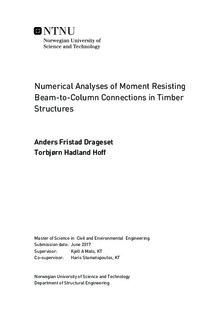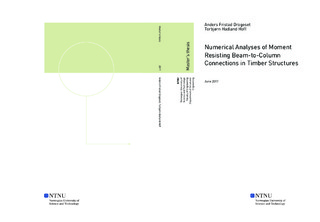| dc.description.abstract | This Master thesis is a continuation of an ongoing study of connections in timber structures with the use of long threaded rods as fasteners. As a part of the research project Wood frame solutions for free space design in urban buildings, the objective has been to optimize a moment resisting beam-to-column connection by use of numerical analyses. The main focus has been optimizing both the inclination angle of the rods and the steel connector between the beam and the column, in order to obtain high rotational stiffness.
Previously two configurations, using connecting circular profile, have been tested experimentally. These were replicated numerically in order to validate the results from the simulations. The rotational stiffness in the numerical models were 10 545 kNm/rad and 13 813 kNm/rad for the two configurations, while the results from the experimental testing were 9 079 kNm/rad and 7 603 kNm/rad respectively. The correlating results
for one configuration, but large discrepancy for the other, were contributed to the inability of the cohesive zone to replicate the experimental withdrawal stiffness for the angles and embedment lengths featured in the latter configuration.
A new steel connector was designed. The concept is a plate bent to accommodate the rod inclinations. The numerical simulations resulted in a higher rotational stiffness than the previously used circular profile.
Nine configurations with varying rod-to-grain angles, connector types and dimensions of the timber components were analyzed. A configuration where the column rods had inclinations of 75 and 70 degrees relative to the grains and the beam rod 5 degrees, achieved the highest rotational stiffness with a magnitude of 20 796 kNm/rad. By comparing the numerical and experimental results, the experimental rotational stiffness may be in the range of 11 404 - 13 783 kNm/rad.
A configuration designed based on fire requirements, possessing a larger width of the timber components, and column rods in different planes, displayed promising results. Although one rod was located within the charring depth, the connection were able to sustain the loading in SLS. | |

